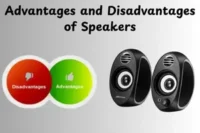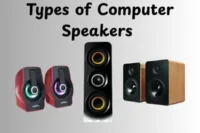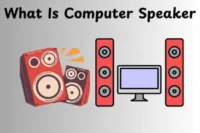Uses of Microphones in Daily Life and Technology
Published: 10 Oct 2025
Did you know microphones are used in almost every part of our daily lives? From online classes and gaming to concerts and studio recordings, microphones play a huge role in communication and entertainment. Along with this, learning the advantages and disadvantages of microphones helps you choose the right one for your needs.Understanding the uses of the microphone helps you see why this small device is so powerful.
Uses of Microphones
Microphones are essential tools that capture sound and make communication, recording, and entertainment much easier. They are used in daily life, professional settings, and creative projects to ensure clear and high-quality audio. Understanding the uses of microphones helps you choose the right type for your needs.
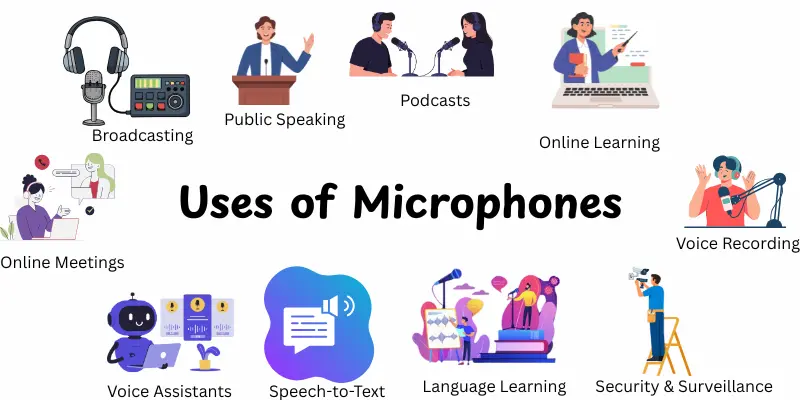
- Voice Recording & Music Production
- Communication & Online Meetings
- Online Learning & Webinars
- Gaming & Live Streaming
- Podcasts & Content Creation
- Public Speaking & Live Performances
- Broadcasting (Radio, TV, Online)
- Voice Assistants & Smart Devices
- Security & Surveillance
- Healthcare & Telemedicine
- Language Learning & Pronunciation Practice
- Speech-to-Text & Accessibility Tools
- IoT & Smart Homes
- AI-Powered Noise Cancellation
- Virtual Reality & Metaverse
Voice Recording & Music Production
Voice recording and music production are some of the most common uses of microphones. Singers use them to record songs in studios. Musicians record instruments like guitar, piano, and drums. People also use microphones to make voice notes or audiobooks. A good microphone makes the sound clear and professional. That is why microphones are very important in music and recording.
Communication & Online Meetings
Communication and online meetings are another common use of microphones. People use them for video calls with family and friends. Students need them for online classes. Office workers use microphones in virtual meetings. A clear microphone makes voices easy to understand. This helps everyone stay connected without confusion.
Online Learning & Webinars
Online learning and webinars need microphones to work well. Teachers use them to explain lessons clearly. Students use mics to ask questions. Webinars also need clear sound for big groups. A good microphone makes learning easy. It helps everyone understand better and stay focused.
Gaming & Live Streaming
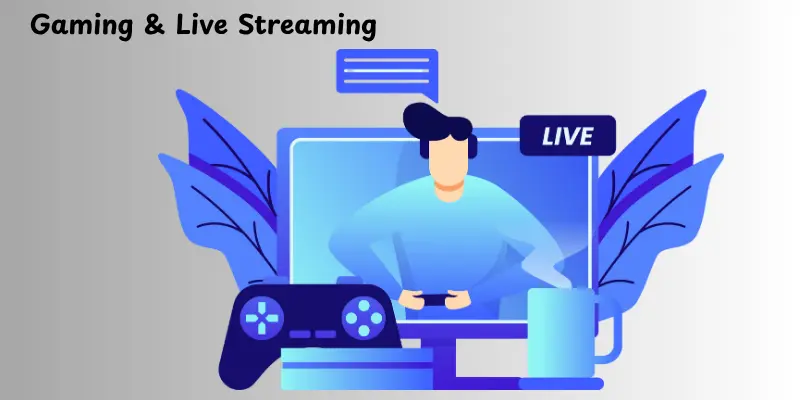
Gaming and live streaming use microphones to connect with others. Gamers talk with teammates during matches. Streamers use mics to chat with viewers. A clear microphone makes the game more fun. It builds teamwork and makes streams exciting. Good sound keeps the audience engaged.
Podcasts & Content Creation
Podcasts and content creation need good microphones for clear sound. Podcasters use mics to share stories and ideas. Creators use them to record videos, tutorials, or reviews. A clear voice makes the content easy to enjoy. It also helps build trust with the audience. Good sound makes content professional.
Public Speaking & Live Performances
Public speaking and live performances always need microphones. They make the speaker’s voice loud and clear. In concerts, singers use a microphone to reach the whole crowd. In events, speakers use them so that everyone can hear. Without a microphone, voices become lost. Without a mic, voices get lost. With it, the message is strong and clear.
Broadcasting (Radio, TV, Online)
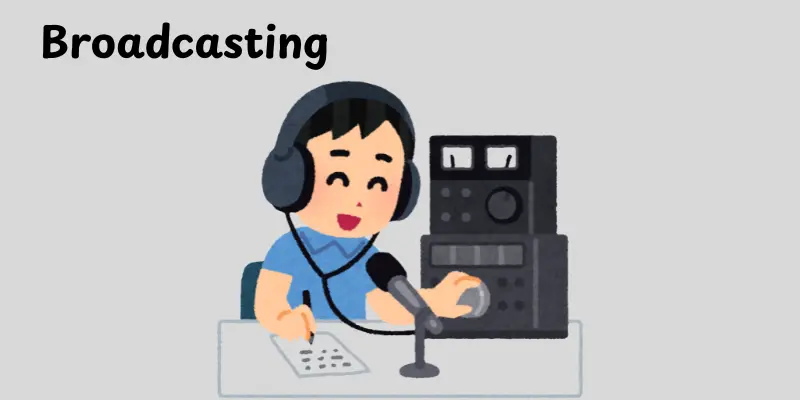
Broadcasting on radio, TV, and online always uses microphones. They make voices clear and easy to hear. Reporters, hosts, and streamers rely on mics for good sound. Without them, audio would be low or unclear. Microphones help deliver news, shows, and online content perfectly. They are essential for all broadcasting.
Voice Assistants & Smart Devices
Voice assistants and smart devices use microphones to hear your commands. Devices like Alexa, Siri, and Google Assistant rely on mics to respond. They can play music, set reminders, and control smart home devices. Without a microphone, they cannot understand you. Microphones make these devices smart and helpful. They are key for hands-free convenience.
Security & Surveillance
Security and surveillance systems use microphones to detect sounds and monitor areas. They help detect unusual sounds or alarms in homes and offices. Microphones work with cameras to provide better safety. They can record voices or alert security teams. These devices make monitoring more effective. Microphones are an important part of modern security.
Healthcare & Telemedicine
Healthcare and telemedicine use microphones to help doctors talk to patients online. They make voices clear during virtual consultations. Patients can explain symptoms easily, and doctors can give advice properly. Microphones also help in recording medical instructions. They are important for online check-ups and health monitoring. Good sound quality improves the overall telemedicine experience.
Language Learning & Pronunciation Practice
Language learning and pronunciation practice use microphones to help learners speak clearly. Students can record their voice and listen to it. This helps improve pronunciation and speaking skills. Teachers can also give feedback online. Microphones make learning languages easier and more effective. They are helpful for practice at home or in classrooms.
Speech-to-Text & Accessibility Tools
Microphones are used in speech-to-text and accessibility tools to turn spoken words into text. This helps users to text without using a keyboard. It is useful for students, professionals, and people with problems with speech. Microphones improve the accuracy and speed of these devices. They are also used in applications and devices for easing communication. Microphones increase accessibility and productivity for everyone.
IoT & Smart Homes
IoT and Smart Homes use microphones to make devices smarter. They listen to voice commands to control lights, fans, and appliances. Microphones help smart speakers and home assistants understand you clearly. They make daily tasks easier and more convenient. With good microphones, smart homes respond quickly and accurately. This technology improves comfort and efficiency at home.
AI-Powered Noise Cancellation
AI-Powered Noise Cancellation helps microphones remove background sounds. It makes your voice clear during calls, recordings, and meetings. The technology uses smart algorithms to block noise like traffic or keyboard typing. It improves sound quality for streaming, gaming, and online classes. With AI noise cancellation, microphones focus only on your voice. This makes communication easier and more professional.
Virtual Reality & Metaverse
Virtual Reality & Metaverse use microphones to make experiences more real. They capture your voice for chatting and interacting with others. Microphones help control actions and commands in virtual worlds. Clear audio makes games, meetings, and events more immersive. They also improve teamwork and social experiences online. Using the right mic enhances your VR and metaverse experiences.
Conclusion
So guys, in this article, we have covered uses of microphones in detail. Personally, I recommend starting with a simple USB or condenser microphone if you want clear sound for online meetings, gaming, or content creation. Take your time to explore a lot of types, and don’t be afraid to choose the perfect microphone and improve your audio experience today!
FAQs
A microphone in a computer allows you to record sound, speak during online meetings, or communicate in games. It improves clarity and sound quality. It also helps in creating podcasts, videos, and other content.
Microphones are used for recording music or podcasts, online meetings, gaming or streaming, public speaking, and video production. They capture sound clearly and enhance communication. Each use improves overall audio quality for its purpose.
Microphones use components like diaphragms, magnets, or crystals to convert sound waves into electrical signals. Some require extra power like phantom power, while USB mics get power directly from the computer. This process makes voices and sounds clear for recording or communication.
Using a microphone improves sound clarity, makes communication easier, and captures detailed audio. It’s useful for meetings, recordings, gaming, and streaming. It also gives a professional touch to any audio or video project.
Yes, USB mics are good for home studios and online work. But XLR mics are better for high-quality professional recording.
Yes, a microphone helps your teacher and classmates hear you clearly. It makes participation easier and more effective. Without it, communication can be unclear or frustrating.
You can reduce background noise by using noise-canceling software or apps. Also, try recording in a quiet room. Some microphones come with built-in filters to block unwanted sounds.
Consider your purpose—recording, gaming, online meetings, or public speaking. Check your budget, portability, and ease of use. Start with a simple USB mic if you’re a beginner for hassle-free setup.

- Be Respectful
- Stay Relevant
- Stay Positive
- True Feedback
- Encourage Discussion
- Avoid Spamming
- No Fake News
- Don't Copy-Paste
- No Personal Attacks

- Be Respectful
- Stay Relevant
- Stay Positive
- True Feedback
- Encourage Discussion
- Avoid Spamming
- No Fake News
- Don't Copy-Paste
- No Personal Attacks


